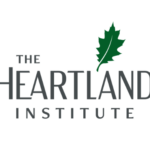Testimony before the Colorado House Health & Insurance Committee
Lindsey Stroud, State Government Relations Manager
Lennie Jarratt, State Government Relations Manager
The Heartland Institute
January 30, 2019
Chairwoman Lontine and members of the Committee, thank you for taking the time today to discuss the issue of local governments regulating tobacco and nicotine products. The Heartland Institute is a 34-year-old independent, national, nonprofit organization whose mission is to discover, develop, and promote free-market solutions to social and economic problems. Heartland is headquartered in Illinois and focuses on providing national, state, and local elected officials with reliable and timely research and analyses on important policy issues. Heartland would like to submit the following testimony.
The legislation proposed today would repeal the current law that prohibits localities from enacting regulations and taxes on tobacco and nicotine products. Currently, if a locality chooses to enact a tax increase, or a regulation restricting access to tobacco products, the county, city or town foregoes the “27% of state cigarette tax revenues.”[i] The proposal being considered would remove that prohibition and allow localities to impose their own burdensome regulations and taxes.
The authors of the bill intend for the proposal to address the concern of teen vaping, notably by allowing localities to raise the age to purchase and possess tobacco and vaping products, from 18 to 21. Although the sponsors have good intentions, measures to raise the age to purchase and possess tobacco are ineffective, and other reforms such as increasing funding for tobacco control efforts would be more worthwhile for public health gains. More candidly, the broad nature of this proposal will lead to unintended consequences, including increased smuggling in localities, and will allow for legislation that places different tobacco products in one category, whereas data continues to show a reduced harm in some tobacco products, including smokeless tobacco and electronic cigarettes. Moreover, the legislation allows localities to retain their share in cigarette tax revenues and provides a mechanism for localities to further rely upon cigarette taxes for budgetary expenses other than tobacco control efforts.
Most everyone can agree that adults shouldn’t use tobacco products, but restricting access to persons aged 21 and over, does not necessarily provide the results the sponsors are seeking. For instance, in the 2018 Monitoring the Future Study: Trends in Prevalence of Various Drugs, the National Institute on Drug Abuse noted more than 53 percent of 12th graders and more than 37 percent of 10th graders reported consuming alcohol in the past year.[ii] The legal age for alcohol possession and consumption in Colorado is 21 and persons found guilty of underage possession can be punished with a “fine up to $250 for a first conviction, $500 for a second conviction, and a jail-able Class 2 Misdemeanor for third and subsequent convictions.” The Colorado Department of Revenue may also “revoke the driver’s license of any person convicted of Minor in Possession of Consumption of Alcohol.”[iii] Under current law, persons under 18 who purchase or attempt to purchase tobacco products “commit a class two petty offense and are subject to a one hundred dollar fine.”[iv] Possession by persons under age 18 is prohibited, but violations are “noncriminal” offenses.[v]
Proposals to increase the tobacco age also fail to recognize how youth are able to secure age-restricted products. A U.S. Food and Drug Administration study found that 86 percent of youths aged “15 to 17 years old obtained cigarettes by asking someone else,” and 89 percent relied on these sources for e-cigarettes.[vi] These so-called social sources include siblings, friends, parents, and even strangers. As indicated in the aforementioned numbers on youth alcohol consumption, youth are able to find social sources to help provide them with products restricted to persons 21 years and older and will merely rely upon these same sources to procure tobacco products.
Although Colorado fares better than most states with allocating tobacco moneys to education and cessation efforts, the Centennial State could be spending more. In 2017, Colorado received $296.3 million “in tobacco settlement payments and taxes.” In the same year, the state spent “$23.2 million in state funds to tobacco prevention,” or about eight percent of what it received from tobacco moneys.[vii] In 2018, the American Lung Foundation gave a Colorado a “D” ranking on the state’s tobacco prevention and control program funding.[viii] In 2019, Colorado will spend $23.6 million on tobacco control efforts or 44.5 percent of the Centers for Disease Control and Prevention’s Annual Spending Target.[ix]
Moreover, very little of Colorado’s cigarette tax revenue goes towards tobacco control programs. Each year, the General Assembly appropriates the “statutory portion of each tax,” with the exception of the required 27 percent being “distributed to local jurisdictions where cigarettes and tobacco products are sold.” In 2004, voters approved Amendment 35, which increased the tax on tobacco products and “specified uses for the additional revenue.” The new revenue is overwhelmingly used to increase enrollment in “the Children’s Basic Health Plan and Medicaid,” and only 16 percent is dedicated to “school and community-based tobacco education programs.”[x]
Allowing different jurisdictions to determine cigarette taxes and regulations create unintended consequences, such as black markets, which force lawmakers to implement additional measures to combat negative externalities. Black markets are particularly prevalent in areas that have high cigarette sales taxes compared to neighboring communities, such as Cook County, Illinois.
Cook County’s $3 tax on tobacco products leads to one of the highest cigarette prices in the United States. The county has implemented a Cigarette Tax Reward Program, which offers monetary awards of up to $250 to persons reporting those seeking to avoid paying cigarette taxes, including people who use unstamped or counterfeit packs or even stray cigarettes.[xi] And although it has been reported $4 million in tobacco citations are written up in Chicago each year, only 15-20 percent actually ends up getting paid.[xii] Should Colorado permit localities to determine their own tax, black markets and smuggling will increase.
Furthermore, the legislation fails to consider the broad spectrum of tobacco products and the relative harms different products provide. Research consistently finds the smoke in combustible cigarettes causes the most harm. With this being understood, tobacco consumers have sought out safer products, most notably smokeless tobacco and snus, and electronic cigarettes and vaping devices, or tobacco harm reduction (THR) products. Research increasingly shows tobacco products exist on a continuum of harm, and THR products are significantly less harmful than combustible cigarettes. Policies regulating their use should not only address this continuum, but validate the products that deliver nicotine with a reduced harm as well as promote their use.
There is more than 20 years of research on the reduced harm smokeless tobacco and snus provide. The Swedish experience with snus, a smokeless tobacco product that is banned in all countries of the European Union except Sweden, provides valuable insight into the harms associated with nicotine used apart from combustible cigarettes. Snus circulates nicotine through users’ bodies in a manner that is consistent with what occurs when people use combustible cigarettes. If nicotine were to cause cancer, “one would expect snus use to be associated with increased risk of lung cancer and many other cancers.”[xiii] However, the evidence indicates that this is not the case. Swedish men have the highest rate of smokeless tobacco use in Europe and the lowest smoking rate. Men in Sweden “also have the lowest rates of lung cancer and other smoking-related diseases in Europe.”[xiv]
Research on electronic cigarettes and vaping devices finds similar reduced harms. In 2015, Public Health England found e-cigarettes to be less harmful than combustible cigarettes, noting that “the current best estimate [shows] using e-cigarettes is around 95% safer than smoking.”[xv] A 2016 report from the Tobacco Advisory Group of the Royal College of Physicians concluded that hazards from e-cigarettes were “unlikely to exceed 5% of the harm from smoking tobacco,” and these products have created “a massive opportunity for a consumer – as well as healthcare – led revolution in the way nicotine is used in society.”[xvi] In 2018, the National Academies of Sciences, Engineering, and Medicine released a report that found “substantial evidence that completely switching from regular use of combustible cigarettes to e-cigarettes results in reduced short-term adverse health outcomes in several organ systems.”[xvii]
Most importantly, public officials should recognize the public health gains these products provide. A 2015 policy analysis by State Budget Solutions examined electronic cigarettes’ effect on Medicaid spending. The author estimated Medicaid savings could have amounted to $48 billion in 2012 if e-cigarettes had been adopted in place of combustible cigarettes by all Medicaid recipients who currently consume tobacco products.[xviii] A 2017 study by the R Street Institute examined the financial impact to Medicaid costs, should a number of current Medicaid recipients switch from combustible cigarettes to e-cigarettes and vaping devices. The author used a sample size of “1% of smokers [within] demographic groups permanently” switching. In this analysis, the author estimates that Medicaid savings “will be approximately $2.8 billion per 1 percent of enrollees,” over the next 25 years.[xix]
Another major problem of the legislation is localities may choose to increase tobacco taxes for programs other than cessation; leaving budgets to rely on shrinking revenues as fewer and fewer people smoke. As indicated in Amendment 35, Colorado voters have already increased taxes on cigarette products to pay for programs other than cessation. Payments provided for by the Master Settlement Agreement are shrinking, and “stares are seeing a 4.5 percent decrease in payments each year.” It is estimated that the “number of people smoking has been decreasing 4 to 5 percent yearly.”[xx] Therefore, localities should refrain from relying on tobacco payments, as this revenue stream is unreliable and continues to shrink.
Rather than allowing localities to regulate nicotine products, Colorado should reform how it currently uses tobacco funds and provide more funding for education and cessation efforts. Should Colorado allow discrepancies between tobacco taxes, certainly black markets will thrive. The legislation also fails to examine the role of THR products and does not recognize the potential health gains these products may provide. Most alarmingly, the legislation will allow localities to rely upon cigarette tax hikes to fund other budgetary obligations and governments should refrain from reliance upon unstable revenue streams.
For more information about The Heartland Institute’s work, please visit our website at www.heartland.org, or contact Lindsey Stroud by phone at 757/354-8170 or by email at [email protected].
[i] HB19-1033, “Local Governments May Regulation Nicotine Products, 2019 First Regular Session, Colorado General Assembly, https://leg.colorado.gov/bills/hb19-1033.
[ii] “Monitoring the Future Study: Trends in Prevalence of Drugs,” Drug Abuse, National Institute on Drug Abuse, 2018, https://www.drugabuse.gov/trends-statistics/monitoring-future/monitoring-future-study-trends-in-prevalence-various-drugs.
[iii] “Colorado Juvenile Criminal Law – MIP – Minor in Possession Laws 18-13-122,” The Law Office of H. Michael Steinberg, 2019, https://www.hmichaelsteinberg.com/juvenile-criminal-cases/colorado-juvenile-criminal-law-mip-minor-in-possession-laws-18-13-122.htm.
[iv] “Tobacco Enforcement,” Colorado Department of Revenue, https://www.colorado.gov/pacific/enforcement/tobacco-enforcement.
[v] “SLATI State Information: Colorado,” The American Lung Foundation, http://www.lungusa2.org/slati/statedetail.php?stateId=08.
[vi] “FDA Study Confirms Youth Reliance on Social Sources,” NATO News, National Association of Tobacco Outlets, March 24, 2016, https://c.ymcdn.com/sites/www.mpca.org/resource/resmgr/2016_Newsletter_Attachments/032816_March_24_2016_NATO_Ne.pdf.
[vii] “Tobacco Use in Colorado,” Truth Initiative, 2017, https://truthinitiative.org/tobacco-use-colorado-2017.
[viii] “State of Tobacco Control,” The American Lung Foundation, 2018, https://www.lung.org/assets/documents/tobacco/state-of-tobacco-control.pdf.
[ix] Laura Bach, “Key State-Specific Tobacco-Related Data & Rankings,” Campaign for Tobacco-Free Kids, December 21, 2018, https://www.tobaccofreekids.org/assets/factsheets/0176.pdf.
[x] Greg Sobetski, “Issue Brief: Use of State Tobacco Revenue,” Colorado Legislative Council Staff, April 2016, https://leg.colorado.gov/sites/default/files/tobacco_moneys_issue_brief_4142016.pdf.
[xi] “Cook County – The Cigarette Tax Reward Program,” Department of Revenue, Cook County, Illinois, 2019, https://apps.cookcountyil.gov/dor/index.php.
[xii] “Cook County Cracking Down On Illegal Cigarette Sales,” CBS Chicago, February 11, 2014, https://chicago.cbslocal.com/2014/02/11/cook-county-cracking-down-on-illegal-cigarette-sales/.
[xiii] Raymond Niaura, “Re-thinking nicotine and its effects,” Truth Initiative, http://vapit.it/wp-content/uploads/2016/12/ReThinking-Nicotine.pdf.
[xiv] Brad Rodu et al., “Vaping, E-cigarettes, and Public Policy Toward Alternatives to Smoking,” The Heartland Institute, February 20, 2017, pp. 12–13, https://heartland.org/publications-resources/publications/vaping-ecigarettes-and-public-policy-toward-alternatives-to-smoking.
[xv] A. McNeill, L.S. Brose, R. Calder, S.C. Hitchman, P. Hajek, and H. McRobbie, “E-cigarettes an evidence update,” Public Health England, August, 2015, https://www.gov.uk/government/uploads/system/uploads/attachment_data/file/457102/Ecigarettes_an_evidence_update_A_report_commissioned_by_Public_Health_England_FINAL.pdf.
[xvi] Royal College of Physicians, Nicotine without Smoke: Tobacco Harm Reduction, April, 2016, https://www.rcplondon.ac.uk/projects/outputs/nicotine-without-smoke-tobacco-harm-reduction-0.
[xvii] Committee on the Review of the Health Effects of Electronic Nicotine Delivery Systems, “Public Health Consequences of E-Cigarettes,” The National Academies of Science, Engineering, and Medicine, 2018, https://www.nap.edu/catalog/24952/public-health-consequences-of-e-cigarettes.
[xviii] J. Scott Moody, “E-Cigarettes Poised to Save Medicaid Billions,” State Budget Solutions, March 31, 2015, https://heartland.org/wp-content/uploads/documents/20150331_sbsmediciadecigarettes033115.pdf.
[xix] Edward Anselm, “Tobacco Harm Reduction Potential for ‘Heat Not Burn,'” R Street Institute, February 2017, https://www.rstreet.org/wp-content/uploads/2017/02/85.
[xx] Jed Kim, “As cigarette sales shrink, so do tobacco settlement payouts to states,” Marketplace, April 15, 2016, https://www.marketplace.org/2016/04/14/life/fewer-smokers-means-looming-defaults-state-bonds.





